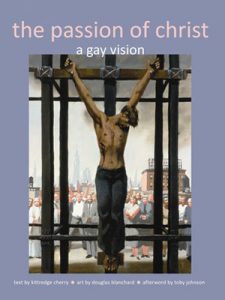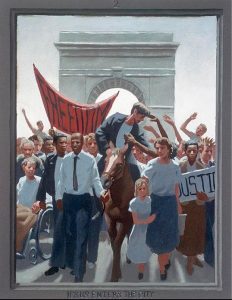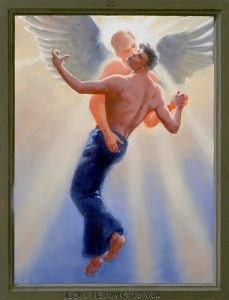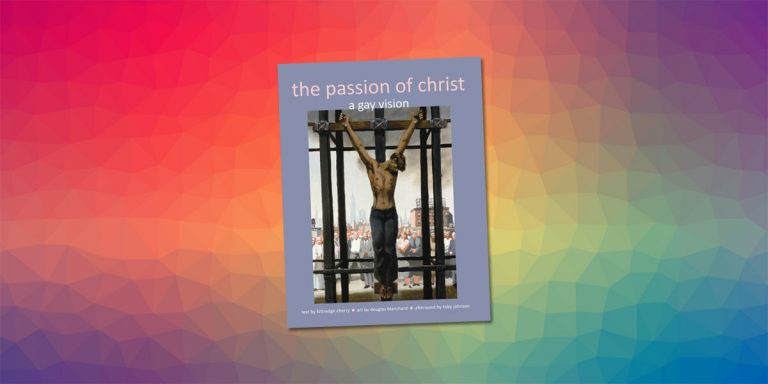 The Passion of Christ: A Gay Vision.
The Passion of Christ: A Gay Vision.
Text by Kittredge Cherry. Art by Douglas Blanchard.
It’s a bit shocking at first – at least to an evangelical believer, even a gay one. The title itself almost slaps you in the face, first luring you with familiar religious tones, then almost sneaking in the punch: “The Passion of Christ: a Gay Vision.” Half of you wants to be outraged; the other half is intrigued. Your first instinct is to flip through the pages, looking at the artwork, with that same reaction: offense and curiosity. “You can’t do this to Jesus. That’s not how it was.” But as you look more closely, you see Immanuel – God with us – portrayed in very human, very modern, terms. And that’s as true to the Gospel story as any classic Renaissance painting of Christ’s passion.
And if you’ll take a few extra moments and actually read a few pages, you’ll quickly fall into a devotional mood. Kittredge Cherry first explains each panel of art, pointing out the symbolism you might otherwise miss, tying the image more closely in with the biblical account it portrays, and then leads us in a moment of quiet reflection and prayer. Far from being outraged, you end up being grateful for this new spiritual experience, this new opportunity to appreciate the work of Christ, and to spend a few moments in awe-inspired prayer. “Help me to make this part of my life.” This might be one of the most interesting devotionals you’ll have on your shelf.
Cherry first began writing commentaries on Blanchard’s images during Holy Week in 2011, and they remain a great way to meditate on the final events of Jesus’ life – at any time of year – just to gain a fresh take on the well-worn story. This collection brings the story to life in a new way with vivid artwork and inspirational writing.
Dallas-born artist, Douglas Blanchard, began working on the 24 panels of his version of the Passion shortly before the attacks of 9/11. Sickened by the results of mindless religion, the terrorist attacks drove him more deeply into the project, motivating him to look beyond the surface of the faith-stories into the real meaning underneath them. And while the images convey meaning many LGBTQ people can relate to, contrary to the impression the title might lend, Jesus is not portrayed as an obviously gay man.
This is no radical repainting of the Christ-story in a politically-hostile, socially-oppressed gay context. Aside from one of the closing shots of Jesus ascending to the Father, there is no real hint of Jesus’ sexual orientation at all. He is simply a young, white male, beardless, athletic and urban – the deliberate attempt by the artist to link Jesus with contemporary life.
The whole point of the series, Blanchard says, is to reflect the message of God in solidarity with us. So instead of depicting Jesus with traditional solemnness and glassy-eyed passivity, holy and unapproachable, the Christ in these paintings is fully human, accessible, someone who draws people to himself instinctively. And in fact, just to prevent the pictures from being taken out of context, Blanchard painted a faux frame around each, complete with title and sequence number.
But a few examples will work better to describe this book than a short review.

The first panel presents Jesus as “The Son of Man,” the human one, identifying with us as one in our sufferings. He’s painted with Job and Isaiah, biblical figures associated with profound suffering. And Cherry’s devotional meditation is powerful:
“And the Word became flesh
and dwelt among us, full of grace and truth.” – John 1:14Jesus was one of us, a real human being. He loved everybody, including his enemies. And yet some say that LGBT people don’t belong in the story of Jesus Christ. … The Holy Spirit inspires each person to envision God in his or her own way. This is the story of a Jesus who emphasized his humanity by calling himself the Human One or Son of Man. He doesn’t look very gay. Young and attractive, he can pass for straight. He is fully in the present, yet feels kinship with the ancient prophets, Job and Isaiah, who understood suffering. He wanted to serve God by healing people and setting them free. Here we remember his last days, his death and resurrection. Jesus was a child of God who embodied love so completely that he transcended history and even death itself. But while it was happening, people didn’t understand. Like many LGBT people, he was rejected by society. They locked the liberator in prison.
Jesus, show me how you lived and loved.
 Or panel #2, “Jesus Enters the City.” Cherry writes,
Or panel #2, “Jesus Enters the City.” Cherry writes,
“Look, the world has gone after him.” – John 12:19
Everyone cheered when Jesus called for justice and freedom. Crowds followed him into the city, shouting and waving. Their chants were not so different from ours: “Yes we can! Out of the closet and into the streets! We’re here, we’re queer, get used to it!” Jesus was a superstar making a grand entrance. But he did it in his own modest, gentle style. He surprised people by riding on a donkey. Some of his supporters, those who had mainstream success, urged him to quiet the others – assimilate, don’t alienate. Tone it down. Act respectable, don’t demand respect. Stop flaunting it. His answer: I’m here to liberate people! If the crowds were silent, the stones would cry out! It was that kind of day, a Palm Sunday sort of day, when everyone shouted for equality and freedom. But was anybody still listening?
Hey, Jesus, here I am!
Panel 3 depicts Jesus driving the money-changers out of the temple, and Cherry leads us to ponder:
“It is written, ‘My house shall be called a house of prayer,’ but you make it a den of robbers.” – Matthew 21:13
Jesus acted up when he saw something wrong. Nothing made him angrier than religious hypocrisy blocking the way to God. He got mad when religious leaders made people pay to attend worship. … Everyone gets God for free. …
Jesus, thank you for your anger.
Give me the courage to act up against injustice.
When Jesus preaches in the temple, and we are led to pray, “Jesus, teach me, touch me!”
At the last supper, the modern Jesus is seen in a sport coat, surrounded by a multi-racial group, from a wide range of ages. An elderly black woman dressed in church clothes and a hat sits next to a young white man in a t-shirt; a young black man with a cigarette stands behind an older white man in a business suit. A young woman in a cocktail dress and heels holds hands with a guy in jeans and a leather jacket. And Jesus stands there, embracing them, hands on their shoulders, with the wine and matzah sitting on the table before him. “This is my body which is given for you. Do this in remembrance of me.” … And we respond, “Jesus, thank you for feeding me!”
Jesus prays alone in a back alley somewhere, the modern Gethsemane. “Guide me, God! I put my life in your hands.” And when he is arrested, we are led to pray, “Jesus, how should I respond to hate?”
There are some provocative images in the book. When Jesus is before the soldiers, we see him sitting naked, handcuffed, with his back to us, as modern soldiers hold a knife to his throat and dogs snarl at him from the side. We see him hanging naked from a pipe as he’s beaten, and blood drips down his back, buttocks and legs. Is this any more graphic or irreverent than what actually happened? “Jesus, be with all who suffer … and with all who cause suffering.” And when he is crucified, we are prompted to pray, “God, help me find meaning in the brutal death of Jesus.” Then follow images of his resurrection, his appearance to Mary, his eating with friends at Emmaus (“Come and travel with me, Jesus. Or are you already here?”)
At Pentecost, “The Holy Spirit Arrives,” painted as a woman in flowing golden gown and wings, descending among a group of black and white men and women, a person in a wheelchair with raised hands in the foreground. “Come, Holy Spirit, and kindle a flame of love in my heart.”
 Perhaps the most controversial painting in the series would be #22, “Jesus Returns to God.” Blanchard deliberately avoids traditional religious language, and translates “the Ascension” into its plain meaning. Here, the shirtless Jesus, wearing blue jeans, is lifted into the sky in the arms of a handsome angel who appears to be kissing him, holding him tightly with one hand on his butt. It is definitely a homoerotic image — but it suggests the intimacy that exists as “mortal human flesh was made radiant by becoming part of God.” If one were to squawk at this book, this would be the gasoline used to light the fire. But within context, and with an anticipated LGBTQ readership, even this image conjures the complex feelings we have integrating our sexuality and our faith. It is true to who we are. And if Jesus took on flesh to walk among us, and identifies with us in our complex humanity, what could be a more potent and suggestive image of the intermingling of his human and divine nature than this?
Perhaps the most controversial painting in the series would be #22, “Jesus Returns to God.” Blanchard deliberately avoids traditional religious language, and translates “the Ascension” into its plain meaning. Here, the shirtless Jesus, wearing blue jeans, is lifted into the sky in the arms of a handsome angel who appears to be kissing him, holding him tightly with one hand on his butt. It is definitely a homoerotic image — but it suggests the intimacy that exists as “mortal human flesh was made radiant by becoming part of God.” If one were to squawk at this book, this would be the gasoline used to light the fire. But within context, and with an anticipated LGBTQ readership, even this image conjures the complex feelings we have integrating our sexuality and our faith. It is true to who we are. And if Jesus took on flesh to walk among us, and identifies with us in our complex humanity, what could be a more potent and suggestive image of the intermingling of his human and divine nature than this?
And that provocative painting might be a good summary of my reaction to this startling work by Cherry and Blanchard. I was reluctant at first, wary to have my faith sensitivities assaulted. But I ended up feeling richer for the experience. As much as my conservative evangelical upbringing might have wanted to cringe at the beginning, I found a deeper truth in the art and commentary that forced those overly-sensitive scruples to shut up and just appreciate the mystery of it all.



